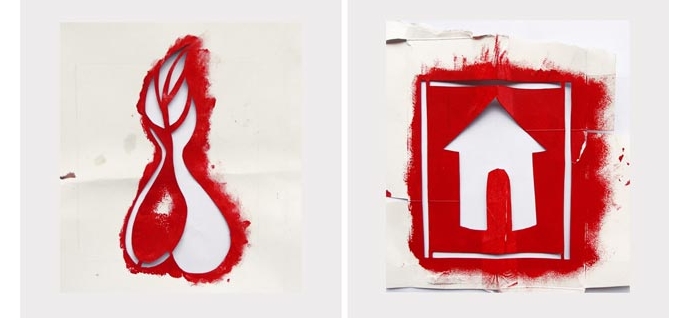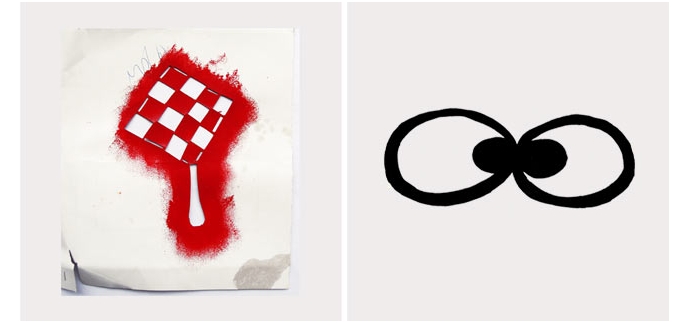|
 |
 |
 |
 |
 |
 |
 |
 |

|
 |

|
 |

|
 |

|
 |

|
 |

|
 |

|
 |

|
 |
 |
 |
 |
 |
 |
-
-
-
-
- catalogue
-
-
-
- Adinkra Update
-
- Ten new "Adinkra" symbols
- Rex Akinruntan, Ralitsa Diana Debrah, Mawuli Dogbatse,
- HMJokinen, Charlie Michaels, S. Daniel Ohene, 2011
-
- The workshop participants discussed the topics of environmental problems in Ghana as well as the privatization of urban space, gentrification and forced evictions of residents. The global and local dimensions of these issues were visualized and linked to the traditional Ashanti Adinkra symbols. New "Adinkra" signs were developed to confront the global challenges. The artist Ralitsa Diana Debrah invited children to print t-shirts with these symbols and to perform an intervention against the aggressive Vodafone company brandings in Ayigya-Zongo.
-
|
 |
 |

|
 |
 |
-
- Ghanaian culture is predominantly a culture of symbols. Numerous objects are decorated with ornamental designs, such as stools, everyday utensils, calabashes, canoes, drums, ceremonial objects, metal works, house walls, and above all, textiles. Adinkra signs are abstractions of proverbs. One of the oldest Adinkra cloths dates back to 1817. Around 60 symbols exist today.
-
- "These messages may be expressed philosophically, satirically or allegorically, to depict religious, social or political concerns as well as reflections on issues pertaining to beauty, morality or other higher vaues. Almost every Adinkra symbol is a literary and non-verbal illustration of a proverb, a parable or a maxim with profound interpretations ... 1)
- It is this combination of simple geometric motifs and complex verbal content that give Adinkra symbols their strong signal character, comparable in a way to that of roads signs. ... 'There may never have been a rigidly standardised set of designs; new motifs have propably always been introduced periodically.' (Cole/Ross 1997)"2)
-
|
 |
 |

|
 |
 |
- Symbols used in Ghanaian architecture.
- left: Ornaments for stools. A Ghanaian stool symbolises a person and her/his soul.
- right: The Adinkra symbols Gye Nyame "except for God", symbol of the supremacy of God and Funtumfunafu Denkyemfunafu (SiameseCrocodiles), "sharing one stomach yet they fight over food".
-
-
- 1) Kojo Fosu, In: Mark Kwami: Communicating without words,
- Adinkra. Symbolic language of the Ashanti, Haus der Kulturen der Welt, Berlin 1993, p. 8
-
- 2) Mark Kwami, i.c. p. 11
-
-
-
-
- Adinkra Update, stencils produced in the AWAY IS A PLACE workshop:
-
|
 |
 |

|
 |
 |
- left: Charlie Michaels: Fihankra Mobile Phone. Fihankra is the symbol for security of one's home, here encased in a mobile phone as a commentary on international mobile phone companies that illegally seize the exterior walls of local homes for advertising.
-
- right: Rex Akinruntan: Out of My Eyes. Africa as a dumping site for the world's garbage.
-
|
 |
 |

|
 |
 |
- left: Charlie Michaels: Bio Fuel Farming. The roots are in Ghanaian soil but the fuel is exported to Western countries.
-
- right: Rex Akinruntan: Akwaaba - Welcome. A Ghanaian stool symbolizes acceptance, even for carbage from the rich countries because it helps people to survive.
-
|
 |
 |

|
 |
 |
- left: HMJokinen: Hwe Mu Dua Crab in a Drinking Water Sachet. The crab is a symbol on fishermen's boats in Ghana. Crab gives birth to a crab. The behaviouf of children often imitates their parents' attitudes. Advice to the adults to live exemplarily lives for their children and to take care of the environment and the purity of water. The two Adinkra symbols Hwe Mu Dua ("measuring stick") stand for best quality, in this case of water.
-
- right: Ralitsa Diana Debrah: Basket - Kenteng (in Ga language) In Ghanaian households baskets are often used for carrying farm produce, fishes as well as garbage and many other daily utensils. Smaller baskets serve as strainers in the kitchen. A basket cannot hold water. The proverb Ake kenteng eyaa faa ("a basket is not used to fetch water") implies that we must learn to do always the right thing.
-
|
 |
 |

|
 |
 |
- left: Mawuli Dogbatse: A symbol with a black drop and a transparent drop of liquid and a plant. This symbol refers to the offshore oil found in Ghana and questions how this will influence water and environment.
-
- right: S. Daniel Ohene: A house as a symbol of security. Against gentrification and forced evictions of shack dwellers.
-
|
 |
 |

|
 |
 |
- left: Ralitsa Diana Debrah: Papa - a fan for pure air ("Mframa pa pa paa"). This type of fan is very popular among traditional folks in Ghana. It is used for fanning when the weather is hot as well as for setting fire in the coal pot for cooking. In some Ghanaian families it is given to a bride as a help to calm her husband down. Today the fan has become more a decorative piece in homes. The fan symbolizes fresh air, and that we should take care of our environment.
-
- right: Ralitsa Diana Debrah: Eyes - himei (in Ga language). The eyes are a symbol for concentration on one thing at a time. This symbol encourages people to be loyal and truthful. The proverb "ake himei enyo kwee to kome mli" means that you cannot use both eyes to look into one bottle. This is a message to the Western world that they should recycle their old computers, fridges and other e-waste in their own countries and make new electronic devices as available for Africa as they are in the west. Western countries should not look double eyed into Africa.
-
-
-
-
|
 |
 |

|
 |
 |
-
-
-
-
-
-
-
-
-
- contact & credits | disclaimer
-
-
-
-
-
|
 |
 |
 |
 |
 |
 |
 |
 |
 |
 |
 |
 |
 |
 |
 |
 |
 |
 |
 |
 |
|
|
|
|